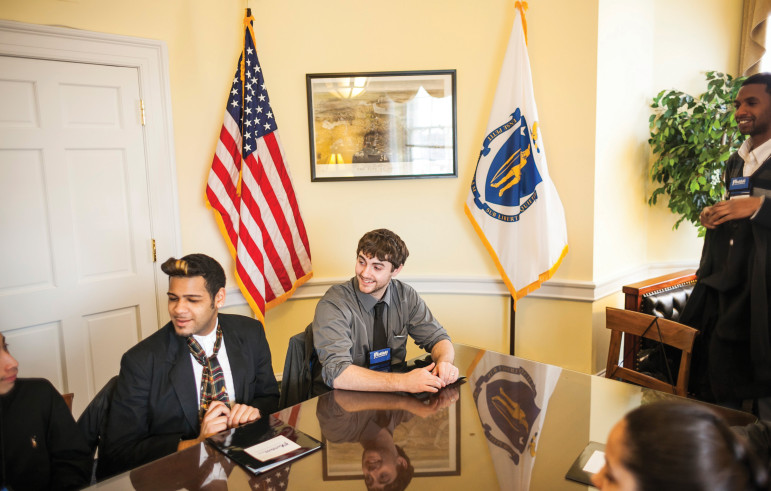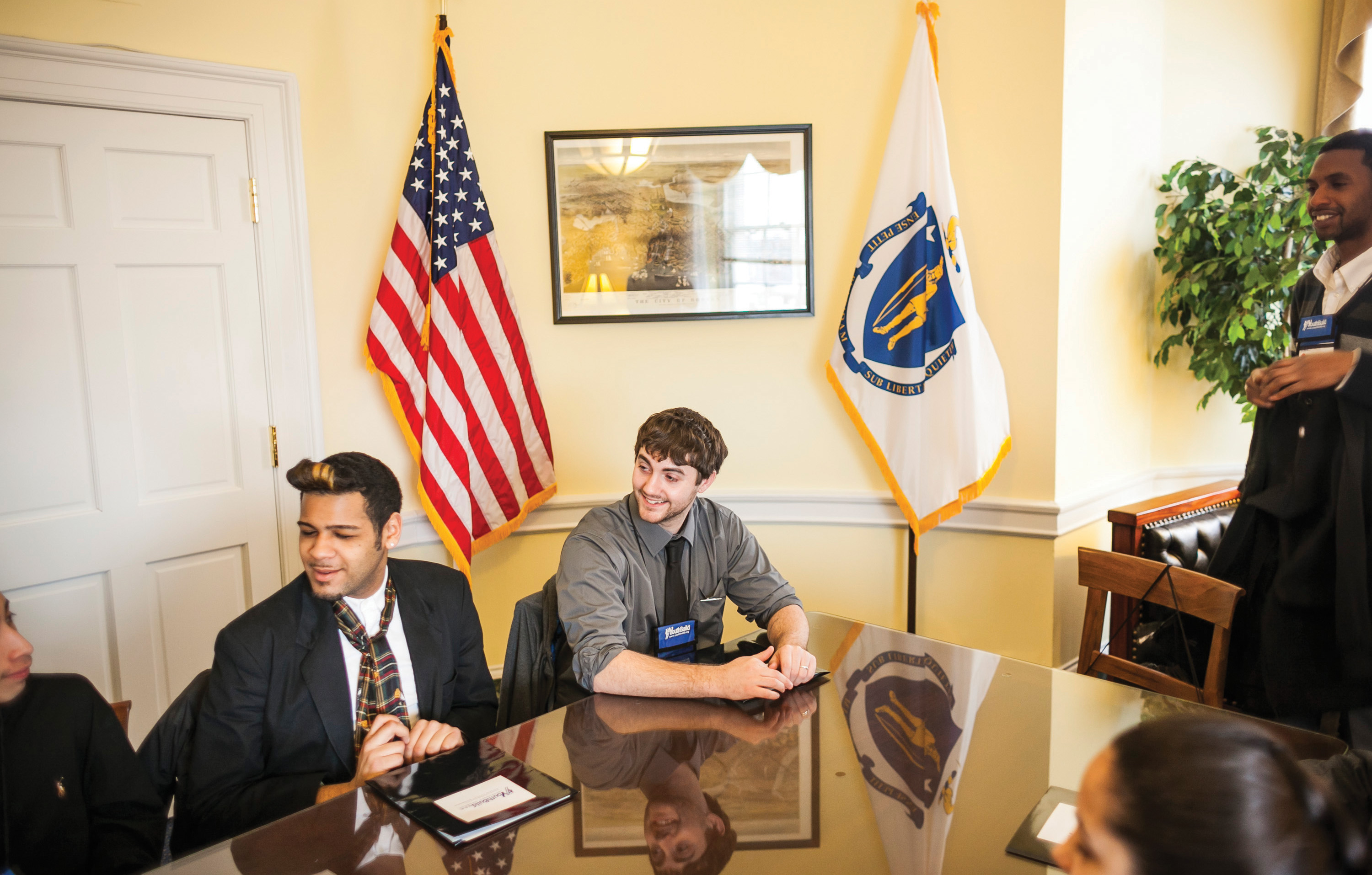
YouthBuild USA
Brandon Stallworth (left) a graduate of Schenectady YouthBuild in Schenectady, N.Y., and Joshua Spear, a YouthBuild Lawrence AmeriCorps graduate from Lawrence, Mass., meet in Rep. Michael Capuano’s office in Washington. YouthBuild USA reserves five places on its 16-member board for young adults who are graduates of its program. Part of the organization’s mission is to develop leadership and civic engagement in young people.
When it comes to writing policies that govern a nonprofit, certain basics usually get covered. Nonprofits draft whistleblower policies, executive compensation policies and conflict of interest policies to comply with the IRS, for example.
But what about setting up policies around inclusiveness?
The question sometimes surfaces when a nonprofit looks around and notices its board is all white. Or staff members become concerned that a particular group of kids — LGBTQ kids or disabled kids, for example — aren’t being adequately served. Or a potential funder raises an eyebrow at the lack of a diversity policy.
“A lot of funders ask questions about that,” said Rick Cohen, director of communications and operations at the National Council of Nonprofits.
Sometimes a gap exists between the organization and the people it serves.
Jan Masaoka, CEO of the California Association of Nonprofits, writes in a “BlueAvocado” article: “Unfortunately, we know many organizations that serve low-income communities of color with no board members of color, no members who have ever been poor, and no members who personally know anyone who is poor.”
One goal of creating a diversity and inclusion policy is to make sure the nonprofit is not “us” serving “them,” Masaoka said.
Donors, participants and the general public expect an organization to reflect the people it serves, said Lynnea Atlas-Ingebretson, program director of the Charities Review Council. How can an organization do a good job understanding the people it serves if they aren’t represented anywhere in the organization, she asked.
However, “diversity tends to be a code word,” Masaoka said. The real question is: “What does your organization need?”
If an organization is a group of women scientists and the mission is to advance women in science, the board doesn’t necessarily need to add male scientists, she said. “I don’t think an all-women’s organization has to have men on the board.”
If 95 percent of the kids in your youth soccer league are white but the area is 40 percent Latino, a large part of the community is not represented, she said.
In that case, Masaoka said, a sample policy statement might read:
“To help us develop relevant services and reach the Latino population we want to serve, we are committed to a staff and board that is comprised of 40 percent or more from the Latino/Hispanic community.”
[module type=”aside” align=”right”]Resources for nonprofits on diversity and inclusiveness
- BoardSource advises nonprofits on board governance and offers a wealth of material and training. It provides a toolkit, “Diversity in Action.” boardsource.org
- Youth on Board helps young people and adults think differently about each other in order to work together to improve society. Resources include a checklist to help nonprofits involve youth in decision-making. youthonboard.org
A diversity and inclusion statement should include how you define diversity, why it matters and how it’s connected to the mission, said Vernetta Walker, chief governance officer and vice president of programs at BoardSource, which advises nonprofits on governance.
Some youth programs try to give young people more voice in the actual running of the organization. “A lot of organizations really try to tap into that voice,” said BoardSource’s Walker.
“There are a lot of ways to do it [well].” Some nonprofits create youth advisory councils, and others create new seats on the board.
A policy at YouthBuild USA is to have young adults on its board. Five graduates of the YouthBuild program sit on the 16-member board, said founder and Chief Executive Dorothy Stoneman.
“Young people have a very significant voice in influencing policy and learning how governance is done,” she said. “Their perspective adds enormous value.”
In 1978, Stoneman asked a group of east Harlem teenagers: “How would you improve your community if you had adult support?”
They answered that they would rebuild the area. “We’d take the empty buildings back from the drug dealers and eliminate crime.”
Stoneman worked with the teenagers to renovate a 10-unit tenement building. The original project grew into YouthBuild USA, which now supports a network of 264 programs in 46 states.
In the program, low-income young people ages 16 to 24 learn job skills while working on their GED. They build affordable housing for homeless and low-income people in their neighborhoods and learn leadership skills.
The organization has an affiliated network in which YouthBuild graduates join YouthBuild program directors in equal numbers to make decisions on program design and performance standards, she said.
The practice is in keeping with the organization’s mission. It offers young people pathways into leadership, Stoneman said.
Steps to inclusive policy
When a nonprofit decides to explore a diversity policy, the first step is to ask several questions, Atlas-Ingebretson said.
- Who is the community we serve? The organization should review the available information, including demographics.
- How do we as an organization reflect the community we serve? The organization should look at its internal makeup, which includes board members, staff, volunteers, vendors and key partners.
- What are some action steps we can take to reduce any barriers to broader diversity and inclusivity?
Written policy statements required by the Internal Revenue Service:
- Conflict of interest policy
- Whistleblower protection policy
- Document retention/destruction
- Executive compensation policy
- Gift acceptance policy
Nonprofits frequently have additional policy statements regarding:
- Donor privacy
- Client eligibility
- Volunteer eligibility
- Personnel eligibility
- Software and technology
- Social media
A number of assessment tools exist to help a nonprofit answer the above questions, Atlas-Ingebretson said. The Charities Review Council offers a questionnaire created by the Minneapolis YWCA.
Youth on Board, a Somerville, Mass.-based youth organization, created a booklet called “15 Points: Successfully Involving Youth in Decision Making,” describing a set of steps organizations can take, including: define decision-making, determine why you want to involve youth, assess your organization and determine your approach.
Committing to diversity and inclusion is a long-term strategy, Walker said. “It’s an ongoing process,” she said.
Masaoka provides a reminder: “There’s not some magic diversity number,” she said. “It’s about what our service populations need.”
































